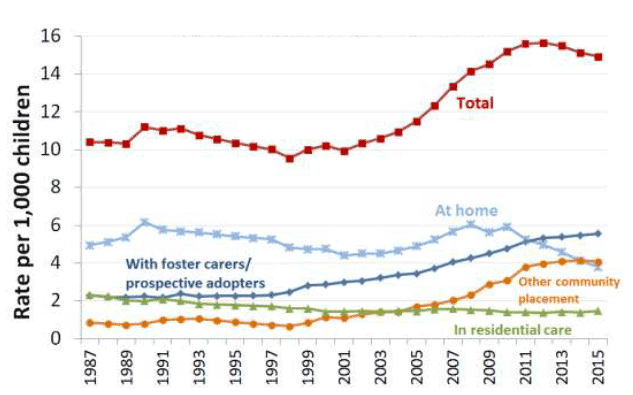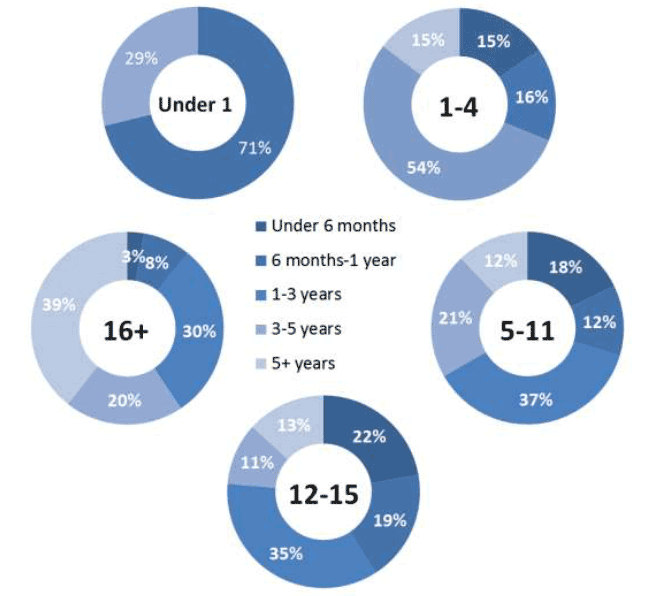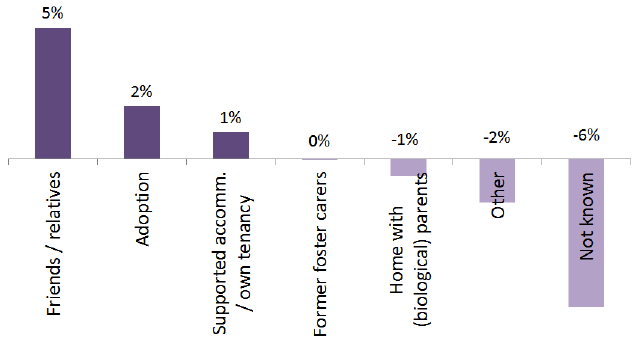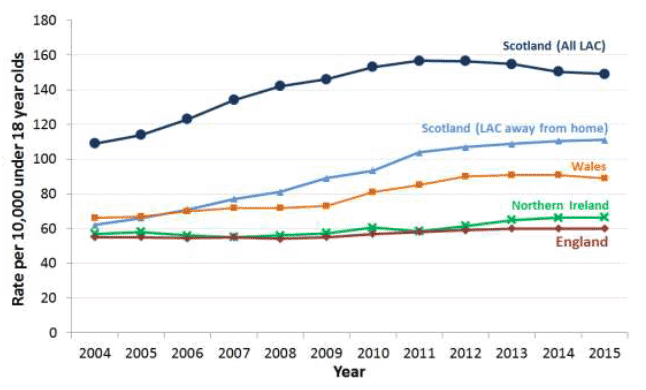Children's Social Work Statistics Scotland 2014/15
A compendium of statistics on looked after children, child protection and secure care statistics for 2014/15.
This document is part of a collection
Children Looked After
 The total number of looked after children has fallen for the third year in a row
The total number of looked after children has fallen for the third year in a row
 The use of permanence orders is increasing year on year
The use of permanence orders is increasing year on year
 Episodes of care continue to lengthen - the number of episodes longer than five years have doubled since 2008
Episodes of care continue to lengthen - the number of episodes longer than five years have doubled since 2008
This section presents data on children looked after during the period from 1 August 2014 to 31 July 2015. This will be referred to as 2015 for ease of reporting (with 2013-14 referred to as 2014 and so on). Local authorities have a responsibility to provide support to certain vulnerable young people, known as 'looked after children'. A young person may become looked after for a number of reasons, including neglect, abuse, complex disabilities which require specialist care, or involvement in the youth justice system.
At 31 July 2015, there were 15,404 looked after children - a decrease of 196 (or one per cent) from 2014. This is the third consecutive year the numbers have decreased following a peak of 16,248 in 2012; the numbers leaving care each year have been consistently more than number starting.
Placement type
There are several types of placement that looked after children or young people could be placed in, including at home (where a child is subject to a Supervision Requirement and continues to live in their normal place of residence), foster care, residential unit or school, a secure unit or a kinship placement (where they are placed with friends or relatives).
Table 1.1 and Chart 1 show there is a continued decreasing trend in children being looked after at home with this group accounting for only 25 per cent of the total in 2015 compared to 32 per cent in 2012. Increasing numbers of children are being looked after away from home in community settings, in particular with foster carers (36 per cent of the total). 2014 was the fourth year running that there were more children looked after by foster carers/prospective adopters than looked after at home: there are now 39 per cent more in these categories. The number of children in kinship care now also exceeds those looked after at home. Numbers of children looked after in residential care settings have been fairly static over recent years, although this year there was a six per cent increase, driven mainly by an increase in the 'other residential' category.
Table 1.1: Number of children looked after by type of accommodation, 2012-2015 (1)
| Type of accommodation | 2012 | 2013 | 2014 | 2015 |
|---|---|---|---|---|
| In the community | 14,815 | 14,566 | 14,133 | 13,875 |
| At home with parents | 5,153 | 4,762 | 4,142 | 3,927 |
| With friends/relatives | 4,076 | 4,183 | 4,217 | 4,158 |
| With foster carers provided by LA | 3,946 | 3,906 | 4,002 | 3,891 |
| With foster carers purchased by LA | 1,333 | 1,427 | 1,520 | 1,587 |
| With prospective adopters | 262 | 243 | 201 | 264 |
| In other community | 45 | 45 | 51 | 48 |
| Residential Accommodation | 1,433 | 1,466 | 1,467 | 1,529 |
| In local authority home | 564 | 575 | 579 | 564 |
| In voluntary home | 90 | 112 | 117 | 133 |
| In residential school | 451 | 439 | 392 | 402 |
| In secure accommodation | 95 | 65 | 82 | 79 |
| Crisis care | 14 | 12 | 15 | 18 |
| In other residential(2) | 219 | 263 | 282 | 333 |
| Total | 16,248 | 16,032 | 15,600 | 15,404 |
(1) Information on the number of children looked after by accommodation type is available back to 1971 in Table 1.1a of the excel version of the publication tables: http://www.gov.scot/Topics/Statistics/Browse/Children/PubChildrenSocialWork
(2) The bulk of the 'other residential' placements are private/independent residential placements for young people with complex needs.
Chart 1: Children looked after per 1,000 children under 18 by type of accommodation, 1987-2015

When children become looked after, a care plan should be produced. The care plan should include detailed information about the child's care, education and health needs, as well as the responsibilities of the local authority, the parents and the child. A care plan is considered 'current' if it has been produced or reviewed in the past 12 months.
Table 1.2: Children looked after with and without a current care plan, at 31 July 2015(1)
| Looked after at home | Looked after away from home | Total | |
|---|---|---|---|
| Number | |||
| With a current care plan | 3,686 | 10,967 | 14,653 |
| Without a current care plan | 241 | 510 | 751 |
| Percentage | |||
| With a current care plan | 93.9 | 95.6 | 95.1 |
| Without a current care plan | 6.1 | 4.4 | 4.9 |
(1) Some children without a current care plan may have one in progress on this date; local recording may differ with regard to when a care plan is recorded as being in place.
Table 1.2 shows that 95 per cent of the 15,404 children who were looked after at the end of July 2015 had a current care plan, a four per cent decrease on 2014. There was little difference between children looked after at home and away from home - 93.9 per cent of those at home and 95.6 per cent of those away from home had a current care plan.
Children starting and ceasing to be looked after
The reduction in total numbers being looked after is simply because more people are leaving care than starting. A child will be counted more than once in each set of figures if they have started being looked after and/or ceased being looked after more than once during the reporting year.
There were 4,198 children who started to be looked after during 1 August 2014 and 31 July 2015 - the lowest figure since 2005. Table 1.3 shows a two per cent decrease from 2014 (4,295) and a 14 per cent decrease from 2010 (4,859).
Table 1.3: Number of children starting to be looked after by age 2005, 2010, 2014-2015 (1),(2)
| Age | 2005 | 2010 | 2014 | 2015 | % 2005 | % 2010 | % 2014 | % 2015 |
|---|---|---|---|---|---|---|---|---|
| Under 1 | 400 | 650 | 700 | 668 | 9 | 13 | 16 | 16 |
| 1-4 | 857 | 1,146 | 1,042 | 933 | 20 | 24 | 24 | 22 |
| 5-11 | 1,255 | 1,463 | 1,303 | 1,305 | 29 | 30 | 30 | 31 |
| 12-15 | 1,644 | 1,555 | 1,198 | 1,232 | 38 | 32 | 28 | 29 |
| 16-17 | 175 | 45 | 52 | 58 | 4 | 1 | 1 | 1 |
| 18-21(3) | - | 0 | 0 | 2 | 0 | 0 | - | 0 |
| Unknown | 2 | 0 | 0 | 0 | 0 | 0 | - | - |
| Total | 4,333 | 4,859 | 4,295 | 4,198 | 100 | 100 | 100 | 100 |
(1) Table excludes planned series of short term placements. The number of looked after children aged 18+ was not asked for prior to 2006. A child may start to be looked after more than once in a year and so may be counted more than once.
Full data by gender and age group for 2003-2015 is available in Table 1.3 of the excel version of the publication tables.
(2) Due to rounding, the percentage totals may not equal the sum of their parts.
(3) The 18-21 category in this table may include a small number of looked after young people who were over 21 years.
Over the last 10 years children have started to be looked after at younger ages. In 2005, 29 per cent of children starting to be looked after were aged under five. By 2015 this had risen to 38 per cent, although this is a three percentage point decrease from last year. The figures have been broadly steady since 2011. A large proportion of this group are the under-one year olds, and the numbers in this youngest group have almost doubled since 2005, but are also mostly static since 2011. There was a corresponding decrease in the proportion of children aged 12+ being looked after (those aged 5-11 remained flat).
There were slightly more boys starting to be looked after in 2015 - 53 per cent compared to 47 per cent of girls; generally there is a fairly balanced gender split with children starting to be looked after.
Table 1.4: Number of children ceasing to be looked after, by length of time looked after, 2005, 2010, 2014-2015(1),(2)
| Length of time looked after | 2005 | 2010 | 2014 | 2015 | % 2005 | % 2010 | % 2014 | % 2015 |
|---|---|---|---|---|---|---|---|---|
| Under 6 weeks | 578 | 342 | 367 | 293 | 16 | 8 | 8 | 7 |
| 6 weeks to under 6 months | 390 | 349 | 398 | 371 | 11 | 8 | 8 | 8 |
| 6 months to under 1 year | 617 | 764 | 646 | 578 | 17 | 17 | 14 | 13 |
| 1 year to under 3 years | 1,308 | 1,811 | 1,739 | 1,619 | 37 | 40 | 37 | 37 |
| 3 years to under 5 years | 395 | 672 | 800 | 739 | 11 | 15 | 17 | 17 |
| 5 years and over | 278 | 566 | 746 | 767 | 8 | 13 | 16 | 18 |
| Total | 3,566 | 4,504 | 4,696 | 4,367 | 100 | 100 | 100 | 100 |
(1) Excludes children who are on a planned series of short term placements. If a child ceases to be looked after more than once during the year they will be counted more than once.
(2) Some totals do not exactly equal the sum of their component parts due to the effects of rounding.
Table 1.4 shows the number of children who ceased being looked after between 2005 and 2015. There were 4,367 children who ceased being looked after between 1 August 2014 and 31 July 2015, a decrease of seven per cent from the 2014 figure (4,696) and the smallest amount of care leavers since 2007. However, this still represents an overall increase of 22 per cent since 2005, the year in which figures reached a low point of 3,566.
The length of time children had been looked after at the point they stopped being looked after remained similar between 2014 and 2015, but longer-term, there are many more children being looked after for more than three years, and many fewer in care for only a period of weeks. This implies that children are more likely to remain looked after until a permanent placement is found.
The length of time spent in care is also related to the age of the child. Clearly, there's a correlation with age, as a child cannot be in care for longer than they've been alive, but there are various different patterns that can be seen in each age group. One notable point is that there's a marked increase in the number of placements of less than a year in the 12-15 age group. This may be related to the changes in family and personal dynamics as children reach puberty.
Chart 2: Length of time children had been looked after when ceasing to be looked after, by age, 2015

Just as children are starting to be looked after at a younger age, children are also ceasing to be looked after at younger ages. The number of children ceasing to be looked after who were under the age of 12 increased by 53 per cent between 2005 and 2015, although it should be noted that 2005 had the fewest care leavers on record. Fuller information can be found in the published Excel tables which accompany this release - see Annex B for details.
Table 1.5: Percentage of children ceasing to be looked after by destination, 2011-2015(1)
| Destination after leaving care | 2010 | 2011 | 2012 | 2013 | 2014 | 2015 |
|---|---|---|---|---|---|---|
| Home with (biological) parents | 62.0 | 60.0 | 68.2 | 67.5 | 65.7 | 61.4 |
| Friends/relatives | 11.8 | 13.1 | 12.1 | 13.8 | 14.4 | 17.0 |
| Former foster carers | 1.9 | 1.2 | 1.3 | 1.3 | 1.7 | 1.8 |
| Adoption | 4.8 | 5.7 | 5.7 | 6.3 | 7.2 | 6.9 |
| Supported accommodation/own tenancy | 5.7 | 6.2 | 5.5 | 5.7 | 6.1 | 6.8 |
| Other(2) | 6.7 | 4.9 | 5.8 | 4.5 | 3.9 | 5.0 |
| Not known | 7.0 | 9.0 | 1.4 | 1.0 | 1.0 | 1.1 |
| Total | 100.0 | 100.0 | 100.0 | 100.0 | 100.0 | 100.0 |
(1) Table excludes planned series of short term placements. A child may cease to be looked after more than once during the year and will be counted once for each episode of care ending. Some totals do not exactly equal the sum of their component parts due to the effects of rounding.
(2) "Other" includes residential care, homeless, in custody and other destination.
Upon leaving care, children are allocated to a destination category (Table 1.5). More than half of children (61.4 per cent in 2014-15) go home to their biological parents and 17.0 per cent go to live with friends or relatives. The percentage leaving care to go home has fallen consistently over at least the last three years. Due to the large number of unknowns before 2012, trends are not as clear for that period. The increase in data quality, as shown by the shrinkage of the 'Not known' category, is illustrated in Chart 3.
Chart 3: Percentage difference by destination between 2010 and 2015

Local authorities are required to carry out a pathway assessment for aftercare services on young people who are over school leaving age but are still looked after within three months of the young person becoming compulsorily supported. These young people should be provided with a pathway co-ordinator who assesses their needs and a pathway plan which outlines how the local authority plans to meet the needs of the young person.
Of those young people who had reached their minimum school leaving age at the time they ceased to be looked after during 1 August 2014 to 31 July 2015, 74 per cent had a pathway plan and 79 per cent had a pathway co‑ordinator. Where a young person's final placement type was 'at home' they were less likely to have a pathway plan or a pathway co-ordinator than if the final placement type was 'away from home'. Table 1.6 shows that, of children whose last placement was at home, 63 per cent had a pathway plan and 66 per cent a pathway coordinator, compared with 81 and 85 per cent (respectively) of those whose final placement type was 'away from home'.
Table 1.6: Pathway plans and nominated pathway co-ordinators of young people who were beyond minimum school-leaving age on the date they ceased to be looked after during 2014-15(1),(2)
| % Looked after at home | % Looked after away from home | Total % | |
|---|---|---|---|
| With a pathway plan | 63 | 81 | 74 |
| Without a pathway plan | 37 | 19 | 26 |
| With a nominated pathway co-ordinator | 66 | 85 | 79 |
| Without a nominated pathway co-ordinator | 34 | 15 | 21 |
| Total | 100 | 100 | 100 |
(1) Figures include all episodes of ceasing to be looked after beyond minimum school leaving age (i.e. a child may be counted more than once).
(2) It may be the case that some young people who don't have a relevant pathway plan/coordinator may be receiving similar support from adult services instead.
Aftercare services
Local authorities have a duty to provide advice, guidance and assistance for young people who - at the point they leave care - have reached minimum school leaving age, referred to as 'aftercare services'. Table 1.7 shows the proportion of young people eligible for aftercare services on 31 July 2015 by age and their economic activity. 'Economic activity' refers to whether a young person was in education, employment or training.
There were 3,599 young people reported to be eligible for aftercare services on 31 July 2015, of whom only 31 per cent were known to not be receiving aftercare, broadly similar to 2014. Forty-seven per cent of those receiving aftercare for whom current activity is known were in education, training or employment. This is a one per cent increase on 2014, although direct comparisons should be treated with caution as numbers are susceptible to fluctuation.
For young people eligible for aftercare, more than half have taken up these services in some way. More of the eldest group (19+) are not in education, training or employment, and more of this group are receiving aftercare.
Being in education, training or employment is correlated with age - there are progressively more in this category as they get older.
Table 1.7: Percentage of young people eligible for aftercare services by age and economic activity, at 31 July 2015(1)
| Economic activity | 15-16 | 17 | 18 | 19+ | All |
|---|---|---|---|---|---|
| In education, training or employment | 32 | 22 | 27 | 30 | 28 |
| Not in education, training or employment | 22 | 29 | 29 | 36 | 31 |
| Not known | 12 | 11 | 9 | 12 | 11 |
| Not receiving aftercare | 34 | 38 | 35 | 23 | 31 |
| Total | 100 | 100 | 100 | 100 | 100 |
| Of those in education, training or employment | |||||
| In higher education | 19 | 14 | 11 | 17 | 15 |
| In education other than HE | 43 | 34 | 37 | 28 | 33 |
| In training or employment | 39 | 52 | 52 | 55 | 52 |
| Total | 100 | 100 | 100 | 100 | 100 |
| Not in education, training or employment | |||||
| - due to short term illness | * | * | * | 2 | 1 |
| - due to long term illness or disability | 0 | * | * | 8 | 6 |
| - due to looking after family | * | * | 9 | 9 | 8 |
| - due to other circumstances | 96 | 88 | 84 | 82 | 84 |
| Total | 100 | 100 | 100 | 100 | 100 |
(1) Cells containing * represent numbers that are suppressed to maintain confidentiality. Due to rounding, the totals for percentages may not equal the sum of their parts.
Cross-UK looked after comparisons
The definition of "looked after children" varies across the countries within the UK. In Scotland children looked after at home are included in the definition and in the statistics whereas, they are usually excluded in the England and Wales statistics. As a result, it is not meaningful to simply compare rates in Scotland with the rest of the UK - we are considering excluding s.25 and s.20 orders to mitigate this. To improve comparability, the Scotland figure at 31 March has been used below, rather than the published 31 July figure.
Chart 4 gives Scottish figures both including and excluding children looked after at home. This shows that, even when children looked after at home are excluded, in the last three years, the rate is still increasing more quickly than in the rest of the UK. Northern Ireland is increasing at a slightly slower rate, England is steady, and Wales has fallen slightly after years of increase. This sharp increase in numbers in Scotland over the past 10 years coincides with a focus on intervening earlier in the lives of vulnerable children and may explain the higher rate in Scotland. This is reflected in the data which shows looked after children tend to be younger in Scotland than the rest of the UK - 12 per cent of looked after children in Scotland are aged 16 or over, compared to 22 per cent in England, 18 per cent in Northern Ireland and 17 per cent in Wales.
Chart 4: Cross-UK comparison of rate of looked after children per 10,000 children, 2001-2015

Links to the cross-UK data underlying Chart 4 can be found in Background Note 1.7. There is more information on the comparability of looked after children data across the UK:
http://www.gov.scot/Topics/Statistics/Browse/Children/socialservicestats
There are additional tables on looked after children available at:
http://www.gov.scot/Topics/Statistics/Browse/Children/PubChildrenSocialWork
Contact
Email: Ian Volante
There is a problem
Thanks for your feedback